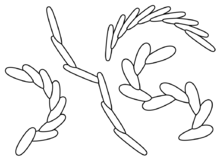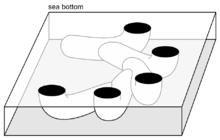- Treptichnus pedum
-
Treptichnus pedum 

Trace fossil classification 
Ichnogenus: †Treptichnus Ichnospecies: †T. pedum Binomial name Treptichnus pedum Synonyms - Phycodes pedum
- Manykodes pedum Dzik, 2005
- Trichophycus pedum
Treptichnus pedum (formerly Phycodes pedum, Manykodes pedum by J. Dzik,[1] or sometimes wrongly named Trichophycus pedum) is regarded as the earliest widespread complex trace fossil. Its earliest appearance, which was contemporaneous with the last of the Ediacaran biota, is used to define the dividing line between the Ediacaran and Cambrian Periods.[2] However, it has since been discovered below the originally defined global boundary stratotype section.[3]
Treptichnus pedum has a fairly complicated and distinctive burrow pattern: along a central, sometimes sinuous or looping burrow it made successive probes upward through the sediment in search of nutrients, generating a trace pattern reminiscent of a fan or twisted rope.[4] The organism that left such traces is considered more complex than earlier Ediacaran fauna; and these trace fossils, which occur worldwide, are usually found in strata above those.[5]
Since only its burrows have been found, it is presumed that the Treptichnus animal lacked any hard anatomical features, such as shells or bones. Its morphology and relationship to modern animals is therefore unknown, and some dispute even its inclusion within the animal kingdom.[6] Despite this lack of fossil evidence, burrows produced by modern priapulid worms are almost identical to Treptichnus, suggesting a close anatomical relationship between the trace-maker and modern priapulids.[7]
The name Treptichnus pedum means "turned-trail (Greek) of feet (Latin)".
References
- ^ DZIK, Jerzy (2005). "Behavioral and anatomical unity of the earliest burrowing animals and the cause of the "Cambrian explosion"". Paleobiology 31 (3): 503–521. doi:10.1666/0094-8373(2005)031[0503:BAAUOT]2.0.CO;2. http://www.paleo.pan.pl/people/Dzik/Publications/PaleobiologyDzik.pdf.
- ^ Subcommission on Neoproterozoic Stratigraphy - URL retrieved June 22, 2009
- ^ Gehling, J.; Jensen, S. R.; Droser, M.; Myrow, P.; Narbonne, G. (March 2001). "Burrowing below the basal Cambrian GSSP, Fortune Head, Newfoundland". Geological Magazine 138 (2): 213–218. doi:10.1017/S001675680100509X. http://www.journals.cambridge.org/action/displayAbstract?fromPage=online&aid=74669.
- ^ McMenamin, Mark A.; Dianna L. McMenamin (1990) [1990-01-15]. The Emergence of Animals. Columbia University Press. ISBN 0-231-06647-3.
- ^ "Life in the Cambrian". http://www.uni-wuerzburg.de/palaeontologie/Stuff/casu8.htm. Retrieved 2006-03-09.
- ^ Altermann, Wladyslaw (2002) [2002-07-01]. Precambrian Sedimentary Environments. Blackwell Publishing. ISBN 0-632-06415-3.
- ^ Vannier, J.; Calandra, I.; Gaillard, C.; Zylinska, A. (2010). "Priapulid worms: Pioneer horizontal burrowers at the Precambrian-Cambrian boundary". Geology 38 (8): 711–714. doi:10.1130/G30829.1. http://geology.gsapubs.org/cgi/content/abstract/38/8/711.

This trace fossil-related article is a stub. You can help Wikipedia by expanding it.
